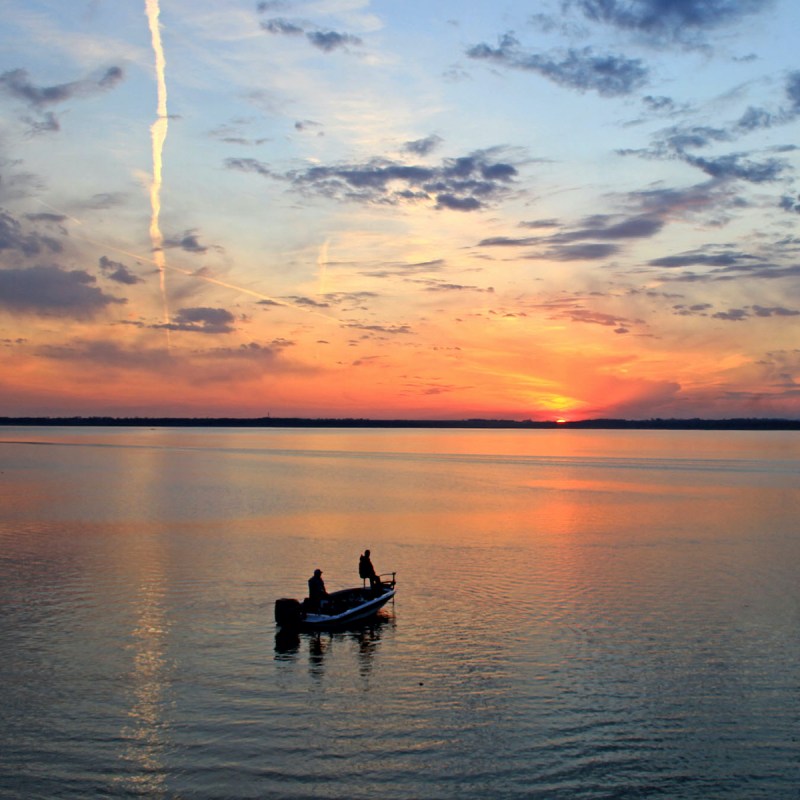
Milford State Park in North Central Kansas is a park for all seasons — and all ages. Whether it’s winter, spring, summer, or fall, all you’ve got to do is call Milford for a fun time. The park is 15 minutes north of Interstate 70’s Exits 290 and 295. The location is a few miles northwest of Junction City, between Abilene and Manhattan.
Videos by TravelAwaits
While the park’s peak visitation is in the spring and summer, each season offers its treasures. Uncover them in these 11 reasons to visit Milford State Park and other parkland surrounding Milford Reservoir.
Geary County Convention & Visitors Bureau hosted me, but all opinions are my own.

Things To Know About Milford Reservoir
Before you head to Milford Reservoir, here are some things to know. Download reservoir maps and brochures here. The Milford Lake map is vital. Use it as a guide to the agencies controlling the area. For example, state park guests need passes. Read the fee schedule and buy them online.
The lake’s northeast shore touches Fort Riley. The area from Madison Creek to the Military Marina can close for training and security reasons. Sometimes the fort’s personnel fire weapons in the area. The public may use the Military Marina’s boat ramp, but only active or retired military may use the marina.
Sailboats are welcome, but must stay south of the bridge.
The United States Army Corps of Engineers (USACE) began digging the lake in 1962. While the contractors were carving the lakebed, they removed significant obstacles. However, fluctuations in the water level can submerge hazards. Don’t neglect your feet. Wear water shoes in rocky areas. Check daily lake conditions on the USACE site.
1. Beach Baby, Beach Baby, Sharing The Sand
Nudie Beach is the reservoir’s most popular white sand beach. The name suggests a clothing-optional site, but don’t be fooled. Water-lovers must wear swimwear. It’s on the reservoir’s north side, where Farnum Creek enters the lake. Nudie is only accessible by boat. Several similar beaches lie between Farnum and Rush Creeks on the east side. Acorns Resort and Flagstop Resort also have boater beaches.
East Rolling Hills Park is a good place for a picnic. It offers a swimming beach and a boat ramp. The ramp is free to use, but the USACE assesses a $5 charge per vehicle to park. USACE maintains three other day-use parks, North Overlook, Outlet, and South Outlet. Pay a fee to reserve USACE’s picnic shelters. If a shelter is not marked as reserved, guests may use it without charge.
Outlet Park also features a swimming beach. However, unlike Rolling Hills, Outlet is free. Thunderbird Marina reserves its beach for swimmers.
Pro Tip: During major holidays, come early to the beaches to beat the crowds.

2. Just A Little Push To Shut Up And Fish
The state’s largest lake is also the Fishing Capital of Kansas. Seasoned anglers can expect to catch some 20 to 50 fish on a good day. The 6.88-pound state record smallmouth bass came from Milford. The lake is also famous for its giant catfish. With its reputation, Milford has hosted many of the nation’s prestigious fishing tournaments. Before you go, buy your fishing license.
The fishing calendar begins in March with catfish and walleye. Find them from School Creek to up north. Then, go to the dam’s face, rocky and drifting points for walleye.
In April, get out jerk baits and jigs for various bass species. Wait until the sun warms the water before fishing.
Crappie, white bass, and wipers take center stage in May. The best bets are shallow areas with gravel and larger rocks mixed together.
Catch big walleye from the end of May into June. The best wiper and white bass fishing come at sunrise and sunset.
Live bait attracts fish from spring to fall. When fishing from the shore, look for river channels or deeper water near the bank.
Pro Tip: No matter the season or the weather, the large lake will provide somewhere to get away from other people. If solitary fishing is your preference, you’ll find it at Milford.

3. Where The Fish Are: Milford Nature Center And Fish Hatchery
You haven’t seen a feeding frenzy until you see the fish hatchery staff throw food into the Milford Fish Hatchery’s fish runs. Immediately, the water fills with thrashing fish eager to grab a piece of food. These fish have a destiny. They will fill the state’s lakes and fishing ponds. Tour the hatchery at 1 p.m. on weekends or by appointment.
Learn more about the fish and other Kansas wildlife at the adjacent nature center. In the reptile area, you’ll learn useful knowledge, like the difference between venomous and non-venomous snakes. (I’d rather not get close enough to tell.) The center’s aquatic and terrestrial dioramas line the walls.
Outside, the center has a butterfly pavilion and a home for birds of prey. A bald eagle’s majestic plumage should provide a deep, resonant voice, right? Instead, the national bird has a high-pitched whistle.
All activities are free, and it’s a great place to take the grandkids.
4. Get Your Motor Running At School Creek ORV
Not everything around Milford Reservoir is about water. Bring your off-road vehicles to School Creek Off-Road Vehicle Area. At School Creek, riders can graduate from kindergarten-level trails to graduate school. The easy trails are on the parking lot’s eastern side. The more challenging routes deliver rugged and narrow hill climbs and play areas. Some of the trails are single track.
The parking lot has room for trailers. Load and unload on the ramp. Ride during daylight hours only. The area allows only motorcycles, dirt bikes, and ATVs. The rules require helmets and spark arrestors.

5. Sportsman’s Acres Is The Place To Be
Practice target shooting and learn about safety and the environment at Sportsman’s Acres. Shoot at three trap ranges, a pistol/rifle range, and an archery range with a 3D archery trail. Geary County Fish and Game Association, which owns the acreage, hosts safety courses and special hunts.
6. Talk To The Trees In The Kansas Landscape Arboretum
More than 1,000 species of woody plants populate the land in the Kansas Landscape Arboretum on the reservoir’s west side. It’s open during daylight hours from March 1 to October 31. Most of the plants are Kansas natives. Wandering the foot trails is easy and calming. Walk slowly and quietly to see cardinals, bluebirds, and woodpeckers. On the Bird Sanctuary Trail, cautiously approach the pond to see waterfowl.
A rickety-looking footbridge crosses the creek that feeds the pond but don’t be afraid of taking it.
7. Hit The Trail, Jack
Numerous trails wind around the lake. The 6.1-mile Eagle Ridge Trail is the longest, running from the state park’s southwest to northeast. Of seven routes, four allow horseback riders, cyclists, and hikers. The other three are for cyclists and hikers only.

8. Let’s Talk About Morels
Morel hunters descend upon Geary County from across the nation, and finding the delicious fungi is a treasurable hunting adventure. Start your search around Milford Lake after a spring rain when the nighttime temperatures are in the high 50s. That’s usually in mid-March. Blooming redbud trees also signal the season.
Early in the spring, search at the forest’s edge. Forage further into the forest as the year advances. Look for south-facing slopes. Find the delectable delight in loose sandy soils at the base of elm, ash, poplar, and apple trees. Trees with bark falling off are a good sign.
Pro Tip: Before you take a bite, verify that you’re eating a morel and not something poisonous. Check out this (PDF) for help.
9. Free Bird In The Wetlands
In the winter, the lake attracts bald eagles and other raptors. Since the water doesn’t freeze over, the big birds can still catch fish. The nature center hosts an annual Eagle Day in January with free events. Attend classes, see live eagle programs, and join bus tours to see wild eagles. State park admission is waived on Eagle Day.
Eight wetland areas surround the reservoir on the Republican River. Most of them have natural vegetation, but some are flooded food plots. The Steve Lloyd Refuge has an overlook where visitors can see birds, mammals, and reptiles.

10. Hit It Hard At Rolling Meadows Golf Course
Rolling Meadows is one of the best golf courses in Kansas. Below the Milford Dam, the course has tree-lined zoysia-grass fairways and tees. Watch out for 29 sand bunkers and six lakes. Tune up your game on the practice range. Buy gear in the pro shop and food at the snack bar.
11. Stay Beside The Lake
Reserve spots at campgrounds in Milford State Park and on USACE land through ReserveAmerica.com. Located in Wakefield, Kansas, Clay County Park is on the northwest part of the lake.
Three private resorts also surround the lake. Acorns Resort has 38 cabins and 61 RV sites. Drive, walk, or boat to The Cove, the resort’s on-site restaurant. Acorns’s guests may golf at Rolling Meadows. Flagstop Resort has nine cabins and 200 RV sites. Thunderbird Marina has 120 RV sites and a restaurant.
Pro Tip
After you catch your fill of fish at Milford, scour your dreams from our Ultimate Fishing Bucket List.
For more information on some of the best Kansas destinations, check out these stories:

